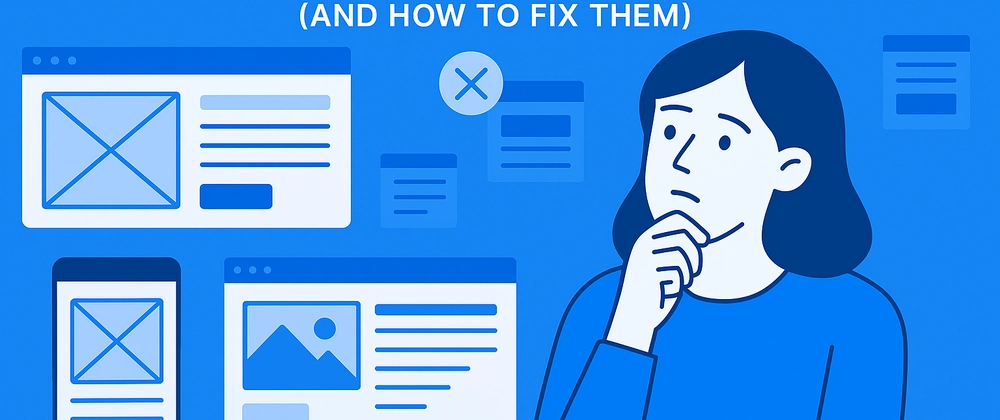Introduction – Avoid These Wireframing Pitfalls
Wireframing is an essential step in UI/UX design, helping teams plan layouts, improve usability, and streamline workflows. But even experienced designers make common mistakes that can lead to confusion, inefficiencies, and costly redesigns.
In this guide, we’ll highlight the most common wireframing mistakes and provide practical solutions to fix them.
1. Skipping Wireframing Entirely
📌 The Mistake:
Some teams jump directly into high-fidelity UI design or development without creating a wireframe. This leads to misalignment, wasted effort, and costly redesigns.
🚀 How to Fix It:
✅ Always start with a wireframe before adding visuals.
✅ Use low-fidelity wireframes to align stakeholders early.
✅ Ensure the wireframe is approved before moving to UI design.
💡 Pro Tip: TaskFrame helps teams integrate wireframing and task tracking, so designs don’t get lost in the process.
2. Making Wireframes Too Detailed Too Early
📌 The Mistake:
A wireframe should focus on structure and functionality—not detailed visuals. Adding colors, fonts, and UI styling too soon distracts from usability and layout planning.
🚀 How to Fix It:
✅ Keep wireframes black, white, or grayscale.
✅ Use placeholders for images and text instead of final content.
✅ Save high-fidelity design for later stages.
🔹 Best for: Keeping the focus on user flow and functionality before visual design.
3. Ignoring User Flows and Navigation
📌 The Mistake:
A wireframe is not just about individual screens—it should map out user flows and interactions.
🚀 How to Fix It:
✅ Define how users will navigate through the product.
✅ Show buttons, menus, and call-to-action (CTA) placements.
✅ Include basic interaction indicators (e.g., hover states, clickable areas).
💡 Pro Tip: TaskFrame enables teams to link tasks to wireframe elements, ensuring that UX decisions are implemented correctly.
4. Overcomplicating the Wireframe
📌 The Mistake:
Adding too many elements, excessive details, or unnecessary features can make a wireframe overwhelming and difficult to use.
🚀 How to Fix It:
✅ Focus on essential features only.
✅ Use clear, simple layouts.
✅ Test with real users to validate simplicity.
🔹 Best for: Ensuring the design remains clean, usable, and intuitive.
5. Not Involving Developers Early On
📌 The Mistake:
Some teams create wireframes without developer input, leading to designs that are difficult or impossible to implement.
🚀 How to Fix It:
✅ Involve developers in wireframing discussions.
✅ Get feedback on technical feasibility before finalizing layouts.
✅ Use a tool that allows real-time collaboration between designers and developers.
💡 Pro Tip: TaskFrame helps teams sync wireframes with development tasks, keeping designs executable from day one.
6. Not Testing Wireframes Before UI Design
📌 The Mistake:
Skipping usability testing at the wireframing stage leads to poor UX decisions that are harder to fix later.
🚀 How to Fix It:
✅ Test wireframes with real users or stakeholders.
✅ Conduct quick feedback loops before moving to high-fidelity design.
✅ Iterate and refine the wireframe based on testing insights.
🔹 Best for: Ensuring the final UI is user-friendly from the start.
7. Using the Wrong Wireframing Tool
📌 The Mistake:
Some wireframing tools lack collaboration features, don’t integrate with task management, or are too complex for simple layouts.
🚀 How to Fix It:
✅ Choose a tool that matches your team’s workflow.
✅ Ensure it supports real-time collaboration.
✅ If your team includes designers and developers, use a tool like TaskFrame that connects wireframing with task tracking.
💡 Why TaskFrame? Unlike tools like Figma, Balsamiq, or Adobe XD, TaskFrame eliminates workflow silos by combining wireframing and task management in one platform.
Conclusion – Wireframing Done Right
Avoiding common wireframing mistakes improves design quality, saves time, and enhances team collaboration.
✅ Always wireframe before UI design.
✅ Keep it simple—focus on structure, not visuals.
✅ Test and iterate before finalizing designs.
✅ Use a tool that connects wireframing to execution.
🚀 Want to streamline your wireframing process and integrate it with task management? Try TaskFrame today!





Top comments (0)